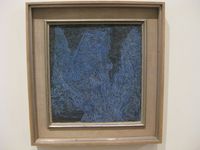Walpurgis Night In Real Life: Difference between revisions
Homerun-chan (talk | contribs) |
Homerun-chan (talk | contribs) |
||
| Line 71: | Line 71: | ||
|- | |- | ||
| style="text-align: right; line-height: 160%; vertical-align: top;"|語感からすると現象だが「そいつ」「倒す」「勝つ」などと言われてたことより敵の名前なのかもしれない。ワルプルギスの夜に現れる敵を仮定して言っていたのかもしれないが。 | | style="text-align: right; line-height: 160%; vertical-align: top;"|語感からすると現象だが「そいつ」「倒す」「勝つ」などと言われてたことより敵の名前なのかもしれない。ワルプルギスの夜に現れる敵を仮定して言っていたのかもしれないが。 | ||
|The sense of the word would make it a phenomenon, but words such as "to defeat", or "to win" could also refer to an ennemy. It might also be possible that ennemies appear during | |The sense of the word would make it a phenomenon, but words such as "to defeat", or "to win" could also refer to an ennemy. It might also be possible that ennemies appear during Walpurgis Night. | ||
Walpurgis Night. | |||
|- | |- | ||
| style="text-align: right; line-height: 160%; vertical-align: top;"|すでに命名がされており、「二人でなら倒せるかもしれない」などという何らかの前提情報が存在するため、今回が初めてではなく過去に例がある現象であると思われる。 | | style="text-align: right; line-height: 160%; vertical-align: top;"|すでに命名がされており、「二人でなら倒せるかもしれない」などという何らかの前提情報が存在するため、今回が初めてではなく過去に例がある現象であると思われる。 | ||
Revision as of 15:12, 27 February 2011
This article is a compilation of historical, mythological, and literary information concerning Walpurgisnacht (ワルプルギスの夜 Warupurugisu no Yoru, Night of Walpurgis), a term first mentioned by Homura in Episode 6. Any speculah regarding this subject should be archived here as well.
Usage of the Term in Canon
In Episode 6
During the arcade scene, Homura mentions "Walpurgisnacht," which is the name of a northern European Spring Festival also called "The Night of the Witches."
|
| |
| Japanese | ほむら: 「2週間後、この街に『ワルプルギスの夜』が来る。『そいつ』さえ倒せたら、私はこの街を出てゆく。」 |
| English | Homura: "In two weeks, 'Walpurgisnacht' is coming to this town. Once I defeat 'it,' I'll leave." |
For clarification, 「そいつ」 -- rendered here in English as 'it' -- is a pronoun that usually refers to a person, and Kyouko's response to Homura made it clear that what was being referred to could be 'defeated.' At present time -- prior to the broadcast of Episode 9 -- it remains unclear if the pronoun used specifically refers to Walpurgisnacht, or whether the term Walpurgisnacht refers to an event or a being (a witch?).
In Episode 8
Documents regarding Walpurgisnacht on display in Homura's apartment contain imagery that strongly resembles the Witch from Episode 1. These are provided as screencaps below. For more information, please refer to Homura's residence page.
Literary & Historical Background
Walpurgis Night in real-life
In Eastern Europe, Walpurgis Night is a night when witches are said to go outside and be particularly troublesome. It is the night from April 30th to May 1st.
In Faust
Faust (part I) contains a scene called "Walpurgisnachtstraum" (the name in brackets is the equivalent character in the anime):
Mephistopheles [Kyubey] notices that Faust's [Madoka's] relation to him is getting lose because of Faust´s love to Gretchen [Sayaka] (a woman Faust made pregnant). He tries to get him motivated again by promising him a fantastic event on the Hexenberg (witch´s mountain). Meanwhile, Gretchen snaps and kills her baby [=Sayaka snaps and becomes a witch]. The event promised by Mephisto is the following:
One the night between April 30 and May 1, the witches meet the devil on the mountain. Faust decides to climb the mountain too, because he thinks he'd be able to solve some riddles there, but Mephisto made him dance with a witch instead. The dance comes to an end when a red mouse falls from the mouth of the witch, and a pretty child appear with a red cord around her neck. This reminds Faust of Gretchen, who has been condemned to death for drowning her child [Sayaka became a witch].
To distract Faust from his feeling of culpability, Mephistopheles then bring him to a hill where a play should be shown.
Paul Klee's painting
The German artist Paul Klee made in 1935 a painting called "Walpurgisnacht". As stated in the page for Episode 8, many fans found that this painting bears similarities with Sayaka's transformation sequence. Whether this is intentionnal or not is still unknown.
Trivia & Minor References
- The exterior view of Homura's residence resembles a scene from Shadow of Memories (Shadow of Destiny for North America). Interestingly, it went through several title changes before release, among them The Day and Night of Walpurgisnacht, Days of Walpurgis, and Time Adventure.
References
Japanese Madoka Wiki
The entry on Walpurgisnacht on the Japanese wiki states the following:
| Original text | Translation |
|---|---|
| ワルプルギスの夜 | Walpurgis Night |
| 第6話にてほむらが2週間後に来ると告げた物。 | Homura announced in Episode 6 that it would come 2 weeks later |
| 現時点では現象なのか敵の名前なのかも不明。 | At this point, it is still unclear whether it is the name of an event or an enemy |
| 語感からすると現象だが「そいつ」「倒す」「勝つ」などと言われてたことより敵の名前なのかもしれない。ワルプルギスの夜に現れる敵を仮定して言っていたのかもしれないが。 | The sense of the word would make it a phenomenon, but words such as "to defeat", or "to win" could also refer to an ennemy. It might also be possible that ennemies appear during Walpurgis Night. |
| すでに命名がされており、「二人でなら倒せるかもしれない」などという何らかの前提情報が存在するため、今回が初めてではなく過去に例がある現象であると思われる。 | As the information exists that "Perhaps it can be defeated by two people" (spoken by Kyouko), it is plausible to presume that Walpurgisnacht has appeared or occurred in the past, and that this current manifestation is not a first. |
| 実際にはヨーロッパで広く知られてる魔女と死者のお祭り。日本でいうお盆のような物。 | In real-life, it is a widespread European festival for witches and deceased. It is equivalent to the Japanese O-Bon festival. |







